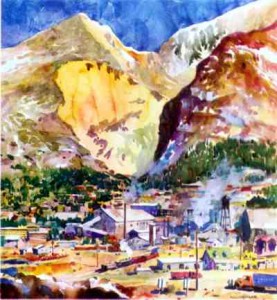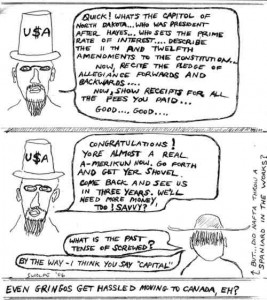Essay by John Mattingly
Agriculture – June 2006 – Colorado Central Magazine
HAL WALTER’S PIECE in the May edition stimulated some thoughts.
I started farming in 1969, and as I recall, Colorado Senate Bill 35, circa 1972, prescribed the 35-acre limit to stop the spread of subdivisions. Land traders responded by chopping up big, open spaces (mostly ranches and windblown bestiaries) into 35-acre subdivisions. But 35-acres is too big for a home lot, and isn’t an economic unit for farming or ranching in the arid West.
There are exceptions that deserve a special pat on the back, but the overwhelming majority of those who inhabit 35-acre tracts are, on a per capita basis, leaving a bigger negative footprint on the planet than any multi-national corporation ravaging the world’s rainforests. Most 35-acre tracts require electric and telephone lines run out to them, a private well drilled, a private sewage system installed, and require the landowner to commute to work. This individualized, isolated infrastructure creates a lot of non-point-source pollution while consuming resources.
SB-35 wasn’t the first time a legislature got it wrong in terms of size. In the late 1800s, when John Wesley Powell crossed the 100th Meridian, he wrote back to Congress that 160 acres was not an economic unit in the arid West. He was ignored. When Powell determined that no less than 2,560 acres was the optimal economic unit west of the 100th Meridian, Congress literally laughed at him.
So the arid West was chopped up into 160-acre units, which in most cases wasn’t enough ground to graze the mules that pulled the homesteader’s covered wagons. In fact, most of the arid West couldn’t be given away in any size denomination and ended up as either BLM or National Forest. Colorado is about 42% public lands, Nevada about 90%, Wyoming about 70%.
In Powell’s case, not only did Congress ignore his good work, they exacerbated their initial misjudgment by opening up the remains of the West to free grazing and free mining, the consequences of which we’re still dealing with today. So forgive me for suggesting it might be best if we don’t look for solutions among the problem-makers at the Statehouse.
Mr. Walter’s friends, who have put together several adjoining properties, are a much better model for action — encumbered, of course, by both the 160-acre and 35-acre regimes of the past. Because these sizes have been given legislative value, there is a perception of value that doesn’t exist in real terms, but must be overcome when one is making acquisitions.
I also have been one to put properties together rather than cut them up. I bought the final phase of the Lazy KV subdivision in 1995, finagled the water rights back to irrigation, and installed three center pivots producing alfalfa, barley, and canola in rotation. It took a couple of years of negotiation to persuade the subdivision owner that a property of 1-acre tracts actually decreased its value, and not just from a farming standpoint. A majority of tracts in the earlier phases of the same subdivision remained unsold, and the 310 one-acre tracts in the final phase hung over the market like carcasses. Returning part of the subdivision to agriculture increased the value of the remaining 1-acre tracts. Or so I successfully argued.
In theory, I favor the concept of taking, say, a half section, 320 acres, and locating ten 1-acre building sites on a select 10-acre piece of the 320, thus using efficiencies of concentration and scale to unify services, and then dedicate the remaining 310 acres to multiple open-space uses.
HOWEVER, THIS RAISES A RED FLAG with the State Engineer’s office because an application for a single well that serves ten households requires bureaucratic steps ironically side-stepped when ten separate applications are submitted for ten individual wells. Further, a small sewage treatment system is required that is more complex than a septic tank dropped in a hole. There are also covenants and proximity issues to be addressed in this alternative model (which are, perhaps, the very issues that should be addressed, but such issues tend to be unfortunately deferred due to the 35-acre model).
Another problem with size. When people learn you’re a farmer, one of their early questions is, “How many acres?”
An answer in the 10s means hobby farmer.
An answer in the 100s means Jeffersonian incorruptible peasant, a small farmer struggling to survive.
An answer in the 1000s means agri-business, probably a big corporate farm, sucking money from government payments while forcing the peasants to sell out.
In fact, the size of a farming operation might better be gauged by some other yardstick than physical size. Gross revenues, number of employees, or market share are more informative. For example, which operation is really bigger? A 10,000 acre ranch that employs one cowboy and has annual revenues of $40,000, or 10 acres of organic strawberries that employs 150 people and has annual revenues of $4 million?
Also, many so-called “family farms” are subsidized by jobs in town or inherited wealth and thus are not economically disciplined. And many so-called “corporate farms” are actually family farms. As a farm passes through generations, a corporate structure offers flexibility and fairness within the family. A retiring farmer can give equal shares to his several children, and those who want to stay with the farm can buy out those who want to move to town. A family farm corporation is often the best structure for vertical integration of an operation, or expansion of the farmland for future generations. The 1999 ag census revealed 90% of the corporate farms in the United States are family corporations with ten or fewer stockholders.
A short comment on the hay business. Hay is an imperfect market, an economic term meaning the market isn’t standardized. There isn’t a daily posted price in the Wall Street Journal for hay as there is for corn, wheat, cotton, cattle, and other agricultural commodities. Hay comes in a staggering variety of kinds, packages, mixtures, qualities, colors, and conditions.
THE HAY MARKET is so local and regional it lacks objective guidance. Buyers tend to emphasize the cheap stack they just bought down the road (omitting that it was two years old and black as coal) and sellers tend to tout the bales they just sold for a fortune (omitting that it was only two bales, hand-plucked from the middle of a big stack).
I’ve exaggerated here to make a point, but it’s not far from the reality of local hay trading: everybody’s a potential market-maker. Stir in the fact that haymaking — particularly alfalfa hay — is as much an art as a science, and it’s easy to see how the combination of egos and uncertainties will likely maintain hay’s imperfect market status.
Finally, the asserted isomorphic relationship between percent snowpack and percent hay crop really doesn’t hold up. A grower’s hay crop is first dependent on the priority, location, and condition of his or her water rights. A grower with first call on a stream, or a strategically located well, might get a 100% crop in a year of 10% snowpack, while the remaining growers get nothing. To claim there is an across-the-board relationship between snowpack and hay crop suggests an egalitarian distribution of snowmelt that simply doesn’t exist. But if I was a hay grower with good water rights, I might highlight a diminished snowpack in conversation with hay buyers, as a way of tenderizing them for the higher price I’d be asking on next year’s crop.
John Mattingly writes when he can’t avoid farming in the greater Moffat non-metropolitan area.


